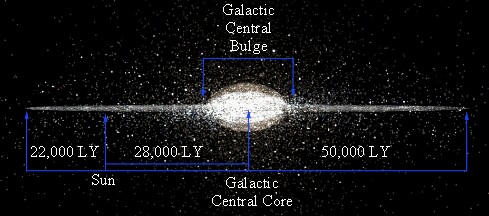
The Milky Way Galaxy is just one of hundreds of billions of galaxies that populate our universe. Our galaxy's name - the Milky Way - is a translation from the Latin "Via Lactea" which is derived from the Greek word "Kiklios Galaxios" which means milky circle. If you go to a dark sky location, the plane of the Milky Way appears as a swath of light across the night sky. There is a Greek myth for the origin of the Milky Way. That is that the baby Heracles is brought by Zeus to Hera to drink her milk so he could become immortal and the Milky Way is nothing more than spilt milk.
It was the Greek Democritus (460-370BC) who first claimed that the Milky Way consisted of distant stars. William Herschel in 1785 made the first map of the Milky Way. Herschel was the first to study and measure the distribution of stars in space. He counted the stars he could see and concluded that the stars were grouped into a huge disk formation and he was right.
 Figure 1. An polar view of the Milky Way Galaxy from overhead.
Figure 1. An polar view of the Milky Way Galaxy from overhead.
In the above polar view of the Milky Way we can see the spiral arms and the dense collection of stars that make up core of the galaxy. The entire galaxy is rotating in a clockwise direction. As to classification, the Milky Way is a SBc barred spiral galaxy. And that red dot above the Orion Arm is the location of the Solar System.
 Figure 2. An edge on view of the Milky Way Galaxy.
Figure 2. An edge on view of the Milky Way Galaxy.
If we look at the Milky Way edge-on from outside our galaxy, Figure 2 is an illustration of the general structure that we would see. We would see a large, flat disk of stars, dust and gas with a dense central ball of stars. Above and below the plane of the Milky Way we would see globular clusters whose distribution is centered about the center of the galaxy. We can't clearly see the galactic center from our location because the interstellar dust clouds between us and the galactic nucleus reduce the amount of light that reaches us from the nucleus by a factor of about 1013.
With estimates of the age of the universe centered around 14 or so billion years old, estimates for the age of the Milky Way galaxy range from 800 million to 13.5 billion years old.
Estimates of the size of the Milky Way galaxy vary due to a degree of uncertainty in the observations used to make these determinations. Estimates for the diameter of the Milky Way galaxy range from 100,000 light years up to 120,000 light years.
As to the size of the galactic bulge that makes up the core of the galaxy, it's diameter is estimated at around 30,000 light years in the north-south direction. The diameter in the equatorial plane is estimated to be 40,000 light years.
Out in the disk of the galaxy, which is where our solar system is located, the thickness of the disk is estimated to be 1,000 light years.
One method that astronomers have used to calculate the mass of the Milky Way galaxy is to use Kepler's 3rd law that relates orbit radius and period with central mass. We figure out the radius of our orbit relative to the center of the galaxy and the period (the time it takes to complete one complete orbit). Plugging those numbers into Kepler's 3rd law we can estimate the mass inside our orbit. Doing the math we come up with a number that is just shy of 100 billion solar masses, with one solar mass being equal to the mass of our Sun. Overall mass estimates of the Milky Way are on the order of 750 billion to 1 trillion solar masses.
If we assume that the average star has a mass equal to the Sun's, we can use the number we arrived at for the galaxy's mass to come up with an estimate for the number of stars. Given that our calculation in the previous paragraph yielded a mass of 100 billion solar masses, we could guess that there are approximately 100 billion stars in the galaxy. Of course somewhere between 2.5 and 3 million of the solar masses are locked up in a super massive black hole named Sagitarius A that's at the center of the galaxy. Other more thorough estimates yield numbers of stars that range up to a high of 400 billion.
Need someone to talk about space to your group? Check out the Chicago Society for Space Studies Speakers Bureau
For space art, astronomy, and digital photography stories, visit the Artsnova Blog
Copyright ©1999-2023, Astrodigital, http://www.astrodigital.org. All rights reserved.
To ask questions, report problems or for general inquiries, see Contact